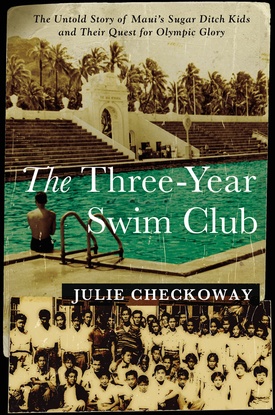My favorite southern California bookstore is in Santa Barbara. Although located in a commonplace strip mall on the outskirts of this picturesque, Spanish-themed resort community, Chaucer’s Bookstore is an enchanted place. This is in part owing to its employees, who are not only lovers of people and books, but also dedicated to nurturing a fruitful relationship between them. But this independent bookstore’s enchantment is due as well to the cosmopolitan makeup of its stock, which goes well beyond the standard-issue best-selling fiction and non-fiction books typifying most chain bookstores. Consequently, I rarely visit Chaucer’s without going home grasping at least one newly published offbeat volume that perfectly suits my taste. Such was precisely the case when, during a recent trip to Chaucer’s, I chanced upon Julie Checkoway’s The Three-Year Swim Club.
Two things prompted me to buy this book. One was the book’s subtitle, which linked Maui youth—most, presumably, of Nikkei ancestry—with potential athletic stardom. I had simultaneously become attuned to this connection through interviewing professional football–baseball great Wally Yonamine (1925–2011), the son of sugar beet workers near Lahaina, who launched his legendary sports career as a student boarder at historic Lahainaluna High School (watch a clip from an interview with Wally Yonamine), and by closely following the fabled three-year collegiate baseball performance at Cal State Fullerton of future American League All-Star Kurt Suzuki (1983– ), an alum of the Maui city of Wailuku’s Baldwin High School.
My second reason for purchasing Checkoway’s book was this accented passage on the cover’s flyleaf: “For readers of Unbroken and The Boys in the Boat comes the inspirational, untold story of impoverished children who transformed themselves into world-class swimmers. Having read and relished both Laura Hillenbrand’s 2010 depiction of Olympic Games track star Louis Zamperini’s “World War II Story of Survival, Resilience, and Redemption” and Daniel James Brown’s 2013 rendering of the proletarian University of Washington regatta squad’s “Nine Americans and Their Epic Quest for Gold at the 1936 Berlin Olympics,” I was hungry for more of the same genre of engaging sports-and-society history.
It is far from hyperbolic for me to declare that The Three-Year Swim Club not merely falls within the same tradition as Unbroken and The Boys in the Boat, but that it likewise deserves the sort of critical and public acclaim enjoyed by them. What Checkoway narrates in vibrant yet disciplined prose in her superbly documented volume is focused on the span from 1937 to 1948, beginning on the island of Maui’s north shore-situated Pu’unene sugar plantation and culminating at the Empire Pool during the “Austerity Olympics” in London. Her book revolves around the vision, dedication, and inventiveness of an idiosyncratic non-swimmer Nisei teacher-cum-swim coach, Soichi Sakamoto. His version of “turning a sow’s ear into a silk purse” consists of miraculously transforming, within a scant three-year period, a mixed-race band of ragtag plantation boys and girls swimming recreationally in concrete irrigation ditches into formal entrants in duly authorized and highly prestigious swimming competitions (held largely at American mainland venues) as a prelude to participation on the USA team at the 1940 Olympic Games scheduled for Tokyo.
While both Coach Sakamoto and his aquatic charges were hamstrung by bureaucratic restrictions, as well as constrained by a shortfall in proper practice facilities and limited access to adequate public and private pools (due to racial and class prejudice), the Three-Year Swim Team (3YST) achieved a widespread reputation for excellence in its sport. Moreover, selected team members (most notably, Keo Nakama, Halo Hirose, and Fujiko Katsutani) won national championships and/or established world records in their specialty events, and all of these individuals were destined to be Olympic performers, had not international wars caused the cancellation of both the 1940 and 1944 Olympic Games. World War II also was responsible for many 3YSTers joining with thousands of other Japanese Americans in the highly-decorated ranks of the segregated 442nd Regiment and 100th Battalion who waged war against the Axis Powers.
By the time that the 1948 Olympics in London rolled around, Sakamoto had taken a position as coach of the University of Hawai‘i swimming team, and only Bill Smith, a 24-year-old Irish-Hawaiian freestyler who had become a 3YST affiliate in 1940, was left to redeem the history and legacy of the club and its embattled mentor, which he did in sterling fashion by winning two gold medals and, in the process, setting new Olympic and world records.
As an epigraph to her “Author’s Notes,” Julie Checkoway quotes the late Rutgers University cultural historian Warren Susman: “The past is not preserved for the historian as his private domain. Myth, memory, history—these are three alternative ways to capture and account for an allusive past, each with its own persuasive claim” (354). I can think of very few works that so exquisitely balance the claims of these three ways in the service of establishing historical truth as does The Three-Year Swim Club. Whether you buy it or borrow it, be sure to do yourself a huge favor and read it.
THE THREE-YEAR SWIM CLUB: THE UNTOLD STORY OF MAUI’S SUGAR DITCH KIDS AND THEIR QUEST FOR OLYMPIC GLORY
By Julie Checkoway
(New York: Grand Central Publishing, 2015, 432 pp., $27, hardcover)
*This article was originally published by the Nichi Bei Weekly, on January 1, 2016.
© 2016 Arthur A. Hansen / Nichi Bei Weekly








